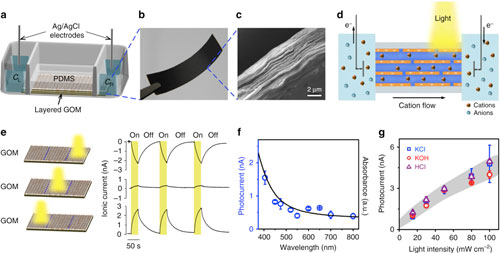| May 09, 2019 | |
Light could drive ions in graphene oxide membranes(Nanowerk News) Scientists have developed a layered graphene oxide membranes (GOM) that showed exceptional ionic and molecular transport were published in Nature Communications ("Photo-induced ultrafast active ion transport through graphene oxide membranes"). |
|
| Recently, a research team led by JIANG Lei and GUO Wei from Technical Institute of Physics and Chemistry (TIPC) of the Chinese Academy of Science developed the GOM with sub-nanometer channels can actively drive the ions in the anti-gradient fashion by asymmetric light irradiation. | |
 |
|
| Photo-induced ultrafast active ion transport through graphene oxide membranes. (© Nature Communications) (click on image to enlarge) | |
| The existing light-control systems for active ion transportation require lipid or liquid membranes that are fragile and hardly compatible with other components. Moreover, energy was consumed on shuttling hinged molecules in the molecular transport systems. | |
| In this work, scientists demonstrated a coupled photon-electron-ion transport phenomenon through the GOM. Cations moved against the electrolyte concentration much faster than the diffusion under the asymmetric light illumination. | |
| They proposed a plausible mechanism that light can reduce the local electric potential on the GOM. Therefore, the potential difference could be observed at the two sides of the channels. Then, the charged ions moved towards the applied opposite polarity. | |
| Based on this assumption, the researchers further constructed photonic ion switches (PIS), photonic ion diodes (PID), and photonic ion transistors (PIT) as the fundamental elements for light-controlled nanofluidic circuits. | |
| This work presents a novel way for remote, non-invasive, and active manipulation of the ion transportation in artificial 2D materials. | |
| By doping the 2D nano-building-blocks with photosensitive elements or molecules, their photo-responsiveness can be further extended for scalable and more precise applications in, for example, active ionic sieving, artificial photosynthesis, and modular nanofluidic computation. |
| Source: Chinese Academy of Sciences | |
|
Subscribe to a free copy of one of our daily Nanowerk Newsletter Email Digests with a compilation of all of the day's news. |
